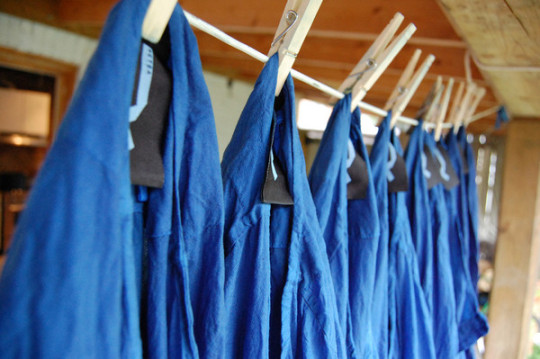Interview: METSA
METSA - an emerging natural inspired collection from Canada features light fabrics, hand dyed to create beautiful, clean items.
Markus the designer behind Metsa provides answers to understand the brands history and future.

When and where did you start Metsa? Could you tell us more about the name, your line and goals? Is Estonian design part of your brand ethos?
Metsa, as it is today started when I was studying graphic design at the Ontario College of Art and Design. I made a small capsule collection, it sold, and I have been working on it ever since.
Before that I was always making things. I have a small family but everyone is some sort of artist/designer so it has always been part of my life. Actually studying graphic design really helped me see a more defined direction for myself in terms of my aesthetic and creative values.
The name Metsa comes a from Minu vaike metsa maja. When I was 8 my grandfather and I built a fort at our cottage and made a sign for it – Metsa is the only word in that phrase that can be said phonetically in Estonian and English.
Estonian design is creeping in the more I make things. It is a craft oriented culture and I am more and more interested in craft techniques and trying to create contemporary objects using them. All of Scandinavia is definitely a big source of inspiration for me in terms of reduction of elements, purity of materials, while still having a bit of playfulness in the items.

Handing dying with natural colorants is timely and beautiful. How did you get started with these materials? Could you walk us through your processes?
I worked as a graphic designer after I graduated and as a result was speeding most of my time on the computer. On the computer you can control everything to the most minute detail and that was really starting to hinder my creativity – I really get hung up on small details. Using natural dyes to colour fabrics was a something I could do after work and on weekends and as a result helped me become really connected with what I was making.
It’s great because ordering fabric is fun but sometimes you can’t find the colors you want, this way I get to take part in a process that allows me to control even more of the design process. The process initially takes a long time, there is a lot of testing and note taking to make sure you achieve the color you want and then are able to recreate the dye bath. However, since they are natural dyes nothing is ever perfect or as you expect – one bath might be more saturated then another because I’m using things like vegetables, roots and flowers. I love that because it really helps me let go of things I can’t control and then design around them.

Some of your shirts offer more unusual dress collars ranging from shawl to club collars offering a modern slant in shirt design. Could you elaborate on your design process?
There are a lot of shirts out there so it is a fun challenge to come up with something that is a little unusual while still remaining classic. Its fun to flip things, quote from other garments and make them work together.
Metsa is fairly androgynous and unisex at the moment. Do you expect to continue in this trajectory or branch in more gendered styles?
Yes, definitely. I love the idea of unisex. When I am designing the items I usually am only considering men so I love it when women approach me or tell me they enjoy wearing Metsa as well. Unisex is something I will definitely keep pushing towards in seasons to come.
Who are some other inspirations and designers pushing your forward?
45RPM, Yoji Yamamoto, Comme Des Garcon. Funnily enough all Japanese. Hoi Bo here in Toronto is doing great things as well. Women’s wear is great to look at. Women’s wear designers take a lot more risks so it is always fun to look at to see what they are doing
Lastly whats next for Metsa?
Of coarse to grow the collection, source more interesting fabrics and incorporate more processes. I would love to work with craftsmen/women who do very traditional items and design something more contemporary while still embracing their traditional process. Like a basket weaver and together make a beautiful bag.